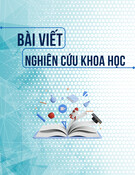
ISSN 1859-1531 - TẠP CHÍ KHOA HỌC VÀ CÔNG NGHỆ - ĐẠI HỌC ĐÀ NẴNG, VOL. 23, NO. 4, 2025 63
AN EVALUATION OF THE VIETNAMESE TRANSLATION OF
“THE THORN BIRDS” BASED ON HOUSE’S MODEL OF
TRANSLATION QUALITY ASSESSMENT
ĐÁNH GIÁ PHIÊN BẢN DỊCH TIẾNG VIỆT CỦA “THE THORN BIRDS”
DỰA TRÊN MÔ HÌNH ĐÁNH GIÁ CHẤT LƯỢNG DỊCH THUẬT CỦA HOUSE
Vo Thi Thu Huyen, Nguyen Thi Thu Huong*
The University of Danang - University of Foreign Language Studies, Danang, Vietnam
*Corresponding author: ntthhuong@ufl.udn.vn
(Received: March 18, 2024; Revised: April 08, 2025; Accepted: April 10, 2025)
DOI: 10.31130/ud-jst.2025.148NN
Abstract – Translation quality plays a crucial role in conveying
information between languages. Accuracy ensures equivalence
between source and target languages, while acceptability
involves adherence to cultural norms, and readability requires
clarity for target readers. In this research, House's (1977)
Translation Quality Assessment Model was applied to evaluate
the Vietnamese translation of the novel "The Thorn Birds" by
Trung Dung (2015), focusing on two dimensions: Dimensions
of Language Use and Dimensions of Language User. This study
illustrates steps in evaluating Trung Dung’s Vietnamese
translation of “The Thorn Birds”, providing examples of
mismatches and errors in comparing the source text and the
target text. Some covert mismatches are found related to the
translation of pronouns and measurement units, while overt
ones involve grammatical discrepancies.
Tóm tắt - Việc đảm bảo chất lượng bản dịch là điều quan trọng
trong việc truyền đạt thông tin chính xác giữa các nền ngôn ngữ
khác nhau. Bản dịch cần đảm bảo độ chính xác hoặc tính tương
đương giữa ngôn ngữ nguồn và ngôn ngữ đích; đồng thời, bản
dịch cũng phải đáp ứng yêu cầu về mức độ chấp nhận thông qua
việc tuân thủ các chuẩn mực văn hóa, và đảm bảo sự rõ ràng, dễ
hiểu đối với người đọc. Nghiên cứu áp dụng Mô hình Đánh giá
Chất lượng Dịch của House (1977) để xem xét chất lượng bản
dịch tiếng Việt cuốn tiểu thuyết "The Thorn Birds" dịch bởi Trung
Dũng (năm 2015) (dưới hai phương diện- “Sử dụng ngôn ngữ” và
“Người sử dụng ngôn ngữ”). Nghiên cứu này minh họa các bước
đánh giá bản dịch của Trung Dũng, đưa ra một số ví dụ về “lỗi”
và sự “chênh lệch” khi so sánh bản gốc và bản dịch. Các lỗi ngữ
dụng được tìm thấy liên quan đến đại từ, đơn vị đo lường trong
khi lỗi ngữ nghĩa liên quan đến sự khác biệt ngữ pháp.
Key words - House's Translation Quality Assessment Model; the
source text; the target text
Từ khóa - Mô hình Đánh giá Chất lượng Dịch của House; văn
bản nguồn; văn bản đích
1. Introduction
Literary translation involves the conversion of written
literary pieces, including novels, poems, plays, and short
stories, from one language to another. This process goes
beyond mere word translation, extending to the
conveyance of the original work's style, tone, and cultural
subtleties. The aim is to safeguard the essence and meaning
of the content in the target language. According to
Lefevere), “translation is the most recognizable type of
rewriting, and it is most influential because it can project
an image of an author and/or on works beyond the borders
of the source culture” [1, p. 17]. It is shown that foreign
language proficiency is necessary but not sufficient to
ensure one's ability to translate literature. This process
demands solid knowledge of language, culture, and
literary, historical, and ethnographic aspects.
Translation Quality Assessment (TQA) plays a crucial
role in facilitating efficient communication across diverse
cultural and linguistic frontiers in the contemporary era of
globalization. As societies become increasingly
interconnected, the demand for precise and culturally
attuned translations escalates. Hewson underscores that
Translation Quality Assessment (TQA) seeks to delineate
the interpretative potential embedded within translation [2,
p.6]. Serving as a mechanism for ensuring quality,
accuracy, and appropriateness of translated content,
translation assessment stands as a pivotal step towards
meeting standards and effectively conveying intended
messages. It scrutinizes translations within a well-
established interpretive framework originating from the
source text. According to House, obtaining translation
equivalency requires taking into account a number of
variables, such as language, text, content, and genre. There
are several equivalency variances in every translation
scenario when comparing the source text (ST) and the
target text (TT) [11, pp. 45-47]. Le Meiyun identified
various distinctions, including morphological, phonetic,
syntactic, lexical, and semantic equivalences [3].
Colleen McCullough's "The Thorn Birds" is one of the
most widely well-known works of foreign literature in
Vietnam. This work has been translated into many languages,
including Russian, French and English. The French
translation, titled “Les oiseaux se cachent pour mourir”, was
carried out by Lagrange and Hall and published by Belfond
in 1978. Meanwhile, the Russian version, “Поющие в
терновнике” (Poyushchie v ternovnike), was completed by
translator Nora Gal in 1986. In Vietnam, two Vietnamese
translations of the novel were released under different titles:
Tieng chim hot trong bui man gai and Nhung con chim an
minh cho che. The former was translated by Pham Manh
Hung and published by the Women Publishing House in
1987 [7]. The latter, translated by Trung Dung and published

64 Vo Thi Thu Huyen, Nguyen Thi Thu Huong
in 2015 [4], was selected for evaluation in this study for many
reasons. Firstly, as a more recent translation, it reflects
contemporary Vietnamese language usage, including
updated vocabulary, syntactic structures, and stylistic norms,
which enhance clarity and reader engagement. Secondly, the
2015 version tends to minimize the use of outdated or formal
expressions that may be less accessible to modern readers,
thus making the translation more natural and fluent. Thirdly,
Trung Dung’s version demonstrates a greater sensitivity to
cultural nuances and idiomatic expressions, aiming for
dynamic equivalence rather than a strictly literal rendering.
This allows for a richer interpretation of the original text's
emotional and thematic layers.
Limited research has been conducted on the assessment
of Vietnamese translation quality. Therefore, the present
study aims to illustrate the application of House’s translation
evaluation model by examining selected extracts from Trung
Dung’s Vietnamese translation of “The Thorn Birds”.
Rather than providing a comprehensive evaluation of the
translation, this study focuses on demonstrating how the
model can be used to analyze the relationship between the
source text (ST) and the target text (TT) [12, p.45].
Theories related to translation evaluation will be
summarized and will be demonstrated by some examples
of comparing the source text and the target text from the
novel “The Thorn Birds” (2015) applying House’s Model
of Translation Quality Assessment.
2. Literature review and theoretical background
2.1. Literature review
The assessment of translation quality has been a central
focus in translation studies, prompting researchers
worldwide to contribute to the development of
comprehensive models. As the author Al-Haddad applies
House’s model to evaluate literary texts, revealing
strengths and weaknesses in linguistic and cultural
equivalence [5]. According to Shakernia utilizes the model
to analyze “The Grapes of Wrath,” assessing covert and
overt translation errors [6]. In addition, Pham’s research
represents a notable departure in translation studies,
focusing on the intricate evaluation of Vietnamese
translations of English news articles [8]. Rooted in House's
Model of Translation Quality Assessment [10], Pham's
meticulous analysis navigates the nuanced challenges of
journalistic translation, with a particular emphasis on
acceptability and equivalence criteria. Through her
comprehensive investigation, Pham contributes valuable
insights into the intricacies of translation quality within
journalism, shedding light on broader cross-cultural
communication complexities [8]. The author's work
emphasizes House's Model of Translation Quality
Assessment is still a valuable tool in various translation
fields, as demonstrated by multiple researchers who have
applied it to different types of texts. It is a comprehensive
approach to translation evaluation, focusing on
functionality and register and genre analysis.
Overall, these studies highlight the applicability of
House's Model in assessing translation quality, uncovering
linguistic, cultural, and contextual nuances. However,
there is a need for more research on the application of
House's model and the complexities of cultural adaptation
in novel translations because the literature does not
sufficiently explore the assessment of translation quality in
particular genres like novels, especially in Vietnamese.
2.2. Theoretical background
2.2.1. House’s Translation Quality Assessment model
German linguist Juliane House, a well-known figure in
translation studies, initially presented her framework for
evaluating translation excellence in 1977 through her work
titled “A Model for Evaluating Translation Quality” [10].
This initial model received considerable critique, leading
to revisions outlined in her updated version published in
1997, named “Translation Quality Assessment: A Model
Revisited” [11].
House’s model has been extensively developed and
utilized within the realm of translation studies,
acknowledged as a potent instrument for gauging translation
quality. This framework offers a holistic methodology,
taking into account myriad crucial elements such as
linguistic nuances and the communicative efficacy of the
translation. Furthermore, it underscores the significance of
appraising the thoroughness, acceptability, and suitability of
translated text, alongside cultural and contextual
considerations during assessment. Consequently, House's
model is esteemed for its adaptability, furnishing an
invaluable framework for enhancing translation quality,
rendering it an optimal selection for multifaceted research
endeavors in translation studies.
House’s model explores the assessment of translation
quality based on linguistic elements and the
communicative purpose achieved in the target language.
Therefore, grasping her model necessitates understanding
the unique “function” of each text, distinct from the
function of language itself. According to House, a text's
function pertains to “the application or use which the text
has in the particular context of situation” [10, p.36]. An
analysis of the source text is necessary in order to
determine the degree of functional equivalency between
the source and target texts, with due consideration given to
the contextual factors shaping its creation. Consequently,
the “situational dimensions” outlined in House's model can
be divided into two main aspects as follows:
A. Dimensions of Language User
1. Geographical Origin
2. Social Class
3. Time
B. Dimensions of Language Use
1. Medium: simple/complex
2. Participation: simple/complex
3. Social Role Relationship
4. Social Attitude
5. Province
To provide more specificity, Language User introduces
three situational dimensions that signify the origin of a text's
producer. Geographical origin denotes the producer's

ISSN 1859-1531 - TẠP CHÍ KHOA HỌC VÀ CÔNG NGHỆ - ĐẠI HỌC ĐÀ NẴNG, VOL. 23, NO. 4, 2025 65
geographical location, typically standardized as British or
American English. Social class indicates the producer's
position on the social hierarchy, typically portrayed as an
educated middle-class speaker of the standard language. Time
offers insights into the temporal context of a text’s origin.
In the aspect of Language Use, House's model introduces
five situational dimensions as follows to facilitate the
analysis of both the source text (ST) and the target text (TT).
Medium may be categorized as either straightforward
(spoken for auditory reception or written for silent reading)
or complex (written for verbal delivery as if not scripted).
Participation can range from simple or complex,
where the text involves features indicating addressee
participation. The term “simple” refers to a monologue or
a dialogue, while “complex” denotes evoking multiple
forms of participation and indirect engagement of the
addressee in a monologue.
Social Role Relationship is the relationship between
the addresser and addressee(s), which may be either
symmetrical (characterized by solidarity and equality, or
asymmetrical) or asymmetrical (marked by some form of
authority relationship).
Social Attitude describes the level of formality or
informality, indicating the degree of social closeness or
distance. Five different styles or levels of formality are
identified by Joos: frozen, formal, consultative, casual, and
intimate [11].
Province not only reflects the broader context of the
text producer's professional and occupational activities but
also encompasses the subject matter or theme of the text,
essentially defining the scope of language usage, including
details of text production inferred from the text itself.
According to Gutt, House’s model aids evaluators in
identifying functional inequivalences, or mismatches,
between the original text and its translation [16, pp. 46 –
49]. These mismatches may stem from translation errors or
from variations in language and culture. House’s model
distinguishes between two kinds of errors.
In House’s model, errors occur when there is a
misalignment between the profiles of the source text and the
translation text. House identifies two categories of errors.
Covertly erroneous errors arise from a discrepancy in a
single situational dimension, meaning they occur when
parameters like field, mode, and tenor are not appropriately
considered during translation. In contrast, overtly erroneous
errors result from a mismatch that goes beyond these
dimensions. These errors can be further subdivided between
examples of uncertain acceptability (where usage norms are
observed) and violations of the target language system,
which include instances of blatant ungrammaticality (where
the rules of the target language are clearly broken).
Mistakes involving the rendition of the literal meanings
of the source text (ST) and translated text (TT) encompass
incorrect selections (resulting from the translator's
erroneous or inappropriate choices when translating the
source text into the target text, such as incorrect word
usage, misinterpreting ideas and concepts, or mishandling
colloquial expressions), improper omissions (omitting
words from the ST during translation), and instances of
ambiguity (resulting in some uncertainty about the
intended meaning).
2.2.2. Definition of mismatches and errors
a. Definition of mismatches
Concerning the evaluation scheme, House acknowledges
that a translation text (TT) is considered appropriate in terms
of translation evaluation provided the dimensions and
subsequently functional match requirements are fulfilled.
Ultimately, “any mismatch along the dimensions is an error”
[11, p.45]. She termed these types of errors as covertly
erroneous errors, which arise from a misalignment of a
situational dimension with a corresponding one in the TT. In
other words, mismatches are characterized as a natural
mismatch between the original text's expected meaning and
its grammatical form, which may cause uncertainty in the
translated version. The absence or choice of words, phrases,
and sentences that deviate from the source text’s intended
meaning, function, or communicative intent can also result
in these mismatches. Three types of incompatibilities are
categorized based on the findings of House's (1997)
evaluation model: syntactic, lexical, and textual mismatches
[11, pp.45-47].
b. Definition of errors
In their book “The Theory and Practice of Translation”,
Eugene Nida and Charles Taber state that the study of
translation errors is related to the accuracy and equivalency of
the translated text with the source text [17]. Similarly, Juliane
House (1977) delves into the analysis of errors in her
translation quality assessment model, focusing on mismatches
between the source text and the translation. House argues that
translation errors occur when the target language fails to
accurately express the content, purpose, or effect of the source
text is not properly conveyed in the target language [10].
Generally, translation errors can be classified based on
their detectability and the extent to which they deviate from
the norms of the target language. Covertly erroneous errors
occur when a translation is grammatically sound but does not
appropriately fit the cultural or situational context, making
them less noticeable without careful examination. Covertly
erroneous errors are examined based on elements of language
use including medium, social role relationship, social attitude
and province. Meanwhile, overtly erroneous errors are more
evident as they break grammatical, lexical, or syntactic rules
of the target language. As highlighted by House, this
classification aids in recognizing errors that either subtly alter
meaning or compromise linguistic accuracy, facilitating more
effective assessment and revision in translation.
3. Findings and discussion
3.1. Profile of the ST
The House’s model will be used to analyze the ST
based on the following two types of dimensions.
A. Dimensions of Language User
1. Geographical Origin
2. Social Class
3. Time

66 Vo Thi Thu Huyen, Nguyen Thi Thu Huong
B. Dimensions of Language Use
1. Medium: simple/complex
2. Participation: simple/complex
3. Social Role Relationship
4. Social Attitude
5. Province
A. Dimensions of Language User
First, Geographical Origin plays a pivotal role as the
story unfolds in the Australian outback. It shapes the
language employed to depict the surroundings, its effects on
characters, and the challenges faced by the Cleary family in
their efforts to sustain themselves from the land. Second, the
social class dimension examines language variations related
to characters' social backgrounds. In the novel, characters
may belong to different social classes, influencing their
speech patterns, vocabulary, and tone. Last, the text
originates from a past timeframe, specifically in 1977.
B. Dimensions of Language Use
In terms of Medium, the assessment involves
examining how language is employed across different
communication channels. Within the novel “The Thorn
Birds”, this Medium encompasses written prose and
narrative techniques.
In terms of Participation, the source text (ST),
characterized by a monologue with embedded (fictional)
dialogic elements, is intricate. In “The Thorn Birds”, the
participants engaged in communication events, along with
their roles, relationships, and perspectives contribute to this
complexity.
In terms of Social role relationship, this aspect delves
into how language mirrors social roles and relationships. In
“The Thorn Birds”, the narrative portrays characters with
clear-cut social roles and relationships, encompassing
family bonds, romantic affiliations, and societal standings.
In terms of Social attitude, this refers to the
articulation of opinions, emotions, and attitudes using
language. Within “The Thorn Birds”, characters express a
variety of social attitudes, spanning from feelings of love
and passion to instances of conflict and resentment.
In terms of Province, the original text, set in Australia,
captures the linguistic intricacies that mirror the cultural
and regional nuances of the Australian context.
3.2. ST and TT comparison
Comparison between the source text (ST) and target
text (TT) according to House’s model situational
dimensions might uncover mismatches in the following
aspects, including medium, social relationship, social
attitude, and province.
3.2.1. Covertly erroneous errors
A. Medium: Syntactic means
TT uses some contacts that are not found in ST, and the
phrase type is changed. These elements could be idiomatic
expressions, cultural references, or phrases specific to the
context that are introduced during translation. Altering the
phrase type means the form or structure of the expression
has been adjusted to better align with the cultural or
contextual framework of the target language. Here are
some examples.
ST
TT
(1) (…) "Agnes! Oh, Agnes!
she said lovingly, blinking at
the doll lying there in a
tattered nest." [12, p.3]
(1) "Agns! Agns! - cô b thì
thầm một cách u yếm, mt sáng lên
khi nhn thy một con bp bê nm
êm ái trong mớ giấy vụn." [4, p.8]
(2) "Wrapping her arms
about him, she took comfort
from him until his nearness
calmed her enough to
become aware of how nice
he smelled, all horses and
sweat and iron." [12, p.11]
(2) "Cô bé càng thu mình sát vào
Frank, tìm kiếm nơi người an niềm
an ủi, cho đến lc cơn xc động
giảm xuống, cô b mới ngửi thấy
cái mùi dể chịu từ thn người của
Frank, đó là mùi ngựa, mùi mồ hôi
và st nung đỏ." [4, p.6]
In the first example, the phrasal verb “nhìn thấy” is
introduced in the target text (TT) to connect the noun
phrases “all horses”, which was restructured into a
subordinate clause “đó là mùi ngựa”. The alteration in the
TT serves the translator’s objective of elucidating and
clarifying the situation. As an example (1), the translator’s
goal is to emphasize overjoy. She was so happy that it sat
still by her mother’s side, being unable to see anything, not
remembering anything but the doll her parents gave her.
Besides, in the example (2), the author wants to emphasize
the panic of the little girl when the doll was thrown to the
ground by her brother’s worker. Until her brother
comforted her, her emotions just dropped.
B. Social role relationship
Regarding the lexical mismatch, the TT and ST diverge
in the following ways about pronoun usage.
ST
TT
(3) "Look, isn't she beautiful?
Her name is Agnes." [12, p.4]
(3) "Các anh xem này, nó đẹp
quá. Nó tên Agns đó." [4, p.3]
(4) "No! Don't, Jack, please don't!
You'll break her, I know you will!
Oh, please leave her alone! Don't
take her, please!" [12, p.5]
(4) "Không, không, Jack! Em năn
nỉ anh. Anh làm hỏng bp bê by
giờ. Em van anh để cho nó yên.
Đừng lấy của em..." [4, p.4]
The usage of pronouns in the extract above reflects the
cultural differences between the ST and TT. The pronoun
“it” is typically used in English when referring to a thing or
animal. However, in this instance, the speaker demonstrates
a desire to show affection for her toy, the pronoun “her” is
used in the lesson. That phenomenon occurs in the above
sentences when the agent expresses her affection for the doll.
Nevertheless, in Vietnamese, the translation does not
maintain the meaning of the words from the ST to the TT, as
these pronouns are rendered as examples (3) and (4) “nó”.
This decision in translation may originate from variances in
cultural perspectives regarding the treatment of objects.
Vietnamese culture might not commonly attribute gendered
pronouns to non-living entities, and the use of “nó”
maintains impartiality, avoiding implications of affection or
attachment based on perceived gender.
Therefore, social role relationships expressed through
pronoun choice reflect cultural norms and attitudes toward
objects and relationships, highlighting differences in
perspectives and values between the source and target
cultures.

ISSN 1859-1531 - TẠP CHÍ KHOA HỌC VÀ CÔNG NGHỆ - ĐẠI HỌC ĐÀ NẴNG, VOL. 23, NO. 4, 2025 67
C. Social attitude
On this dimension, in terms of lexical means, the
translator adds more abundant words "Một phép mầu thật"
(5), “Tôi không thể nào lầm” (6) in the target text (TT).
This adjustment might stem from the translator’s effort to
enhance naturalness and align the text with the nuances of
the Vietnamese writing. The example is presented below:
ST
TT
(5) "A miracle indeed. Only
once in her life had Meggie
been into Wahine; all the
way back in May, because
she had been a very good
girl." [12, p.2]
(5) "Đng là một php mầu. Một
phép mầu thật. Từ trước đến nay
Meggie mới đến cửa hàng Wahine
chỉ một lần thôi, hồi tháng 5 vừa
rồi, cô b được cha mẹ thưởng vì
đã tỏ ra rất ngoan" [4, p.2]
(6) "You have to be Mary's
brother; you're the living
image of her." [12, p.96]
(6) "Tôi không thể nào lầm, ông
đng là em trai của bà Mary, ông
giống bà ấy như hai giọt nước"
[4, p.69]
In House’s framework, “social attitudes” refers to the
translator’s understanding of the social context and
customs of the target language. Here, the translator’s
choice to add extra terms in the TT shows an awareness of
how language is socially utilized and understood in
Vietnamese culture. By adding these expressions, the
translator aims to capture the tone and style that
Vietnamese readers value, demonstrating social sensitivity
to language use in the target society.
Consequently, this example is tightly connected to the
“social attitudes” dimension of House’s model because it
highlights the translator’s awareness of social norms and
traditions in the target language, particularly through
vocabulary choices that enhance authenticity and cultural
consistency.
D. Province
Regarding syntactic structures, Vietnamese pronouns
can vary based on gender and formality, and they might not
consistently correspond with English pronouns. Ensuring
precise pronoun usage poses a challenge. Upon examining
both the ST and TT, specific discrepancies arise
concerning pronouns and their references. For instance:
ST
TT
(7) "His left eyebrow flew
up. "My dear Mrs. Carson,
you're a Catholic. You know
my vows are sacred. Until
my death I remain a priest. I
cannot deny it." [12, p.76]
(7) "Bà Carson thân mến, bà là một
tín đồ công giáo - ông nói, mày
nhíu lại. - Bà biết rng ước nguyện
của tôi là thiêng liêng; tôi không
thể từ bỏ. Tôi sẽ mãi mãi là linh
mục cho đến chết." [4, pp.54-55]
(8) "I thought you were
perhaps a man who
doubted." [12, p.78]
(8) "Tôi nghĩ ở cha cũng có sự hoài
nghi." [4, p.57]
Example 7 illustrates the omission of “my” in the
Vietnamese translation, while Example 8 demonstrates the
absence of “the man who” in the TT. In the translation
process, the translator often refrains from translating
pronouns and their references to create clearer sentences.
Mismatched translations of pronouns and their
references from English to Vietnamese can create significant
hurdles for readers trying to fully understand the intended
meaning. English employs pronouns flexibly, relying on
context for reference, whereas Vietnamese requires explicit
antecedents to avoid ambiguity. This contrast can lead to
subtle yet impactful differences in translated texts [14], [15].
One common challenge is the translation of gender-neutral
pronouns like “they” in English, where Vietnamese lacks a
direct equivalent. Pham and Dinh [9] explain that translators
may choose gendered pronouns or rephrase sentences,
potentially altering nuances or revealing information
prematurely, affecting readers’ perceptions of characters and
relationships. Additionally, English distinguishes between
singular and plural second-person pronouns (“you” and “you
all/y'all”), while Vietnamese does not. Translators must
decide based on context, potentially impacting power
dynamics and intimacy levels in the narrative. Furthermore,
omitting or altering pronoun references can obscure crucial
story elements, as pronouns subtly convey emotions, power
dynamics, and information flow. Errors in translating these
nuances can impede reader comprehension and engagement.
In conclusion, translation discrepancies involving
pronouns and their references between English novels and
Vietnamese translations are intricate and can significantly
affect reader comprehension. Translators must navigate
these challenges to preserve the original text's subtleties
while considering each language’s distinct features.
Readers should be aware of these complexities to
appreciate the skill and artistry involved in producing
translations that capture the essence of the source material.
ST
TT
(9) "it can rise sixty feet in a
night." [12, p.101]
(9) "có lần lên cao đến mười bảy
mét trong một đêm" [4, p.75]
(10) "Drogheda had two hundred
and fifty thousand acres. Its
longest boundary stretched for
eighty miles. The homestead was
forty miles and twenty-seven
gates away from Gillanbone, the
only settlement of any kind closer
than a hundred and six miles."
[12, p.104]
(10) "Drogheda có một diện tích
cả trăm ngàn hecta. Đường ranh
dài nhất có tới một trăm ba
mươi kilômét. Sáu mươi lăm
kilômét và hai mươi bảy cái cổng
rào ngăn cách căn nhà chính với
Gillanbone, điểm dn cư duy nhất
nm trong vòng một trăm năm
mươi kilômt" [4, pp.49-50]
In the instances (9) and (10), the translator chose
synonyms for measurement units to increase the familiarity of
the translated text for readers. While “miles” and “Fahrenheit
degrees” are typical in English-speaking countries, the
translator substituted them with “mét” and “kilômét”, which
are more familiar to Vietnamese readers and provide a
relatable measure for distance. As a result, the translator opted
for the synonyms “mét” and “kilômét” to make the
measurement terms more accessible to the target audience.
The lexical mismatch in the form of synonym choice, where
the translator chose culturally and linguistically relevant
measurements, contributes to the effectiveness of the
translation. It enhances the readability of the translated text for
the target audience, preventing potential confusion that might
arise from unfamiliar units of measurement.
3.2.2. Overtly erroneous errors
In addition to the previously mentioned mismatches
from the ST, the TT exhibits additional deviations.
Firstly, concerning violations of the target language
system, the TT exhibits some grammatical errors,
illustrated as follows.

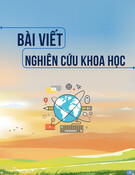
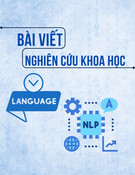





![Phương pháp dóng hàng câu tự động cho văn bản Trung Quốc cổ điển - Việt Nam hiện đại [chuẩn SEO]](https://cdn.tailieu.vn/images/document/thumbnail/2025/20250715/nomoney11/135x160/99021752553566.jpg)
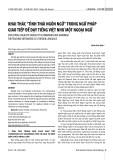
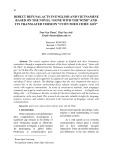
![Bộ câu hỏi trắc nghiệm Văn bản tiếng Việt [chuẩn nhất]](https://cdn.tailieu.vn/images/document/thumbnail/2025/20251127/thuynhung051106@gmail.com/135x160/24021764296609.jpg)
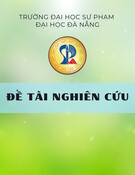

![Bài giảng Ngôn ngữ học đối chiếu Nguyễn Ngọc Chinh [PDF]](https://cdn.tailieu.vn/images/document/thumbnail/2025/20251101/vovu03/135x160/7471762139652.jpg)

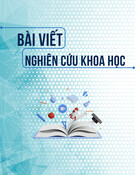
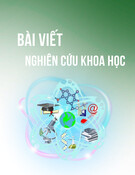
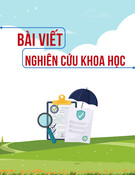
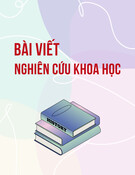
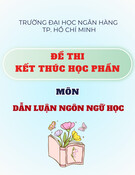

![Ngân hàng câu hỏi môn Tiếng Việt thực hành [chuẩn nhất]](https://cdn.tailieu.vn/images/document/thumbnail/2025/20251003/kimphuong1001/135x160/21861759464951.jpg)
![Bài giảng Văn học phương Tây và Mỹ Latinh [Tập hợp]](https://cdn.tailieu.vn/images/document/thumbnail/2025/20251003/kimphuong1001/135x160/31341759476045.jpg)

